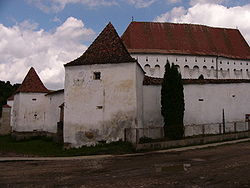- Dârjiu
-
Dârjiu
Székelyderzs— Commune — 13th Century UNESCO World Heritage fortified Unitarian Church, and some geese Location of Dârjiu Location of Dârjiu Coordinates: 46°12′N 25°12′E / 46.2°N 25.2°ECoordinates: 46°12′N 25°12′E / 46.2°N 25.2°E Country  Romania
RomaniaCounty Harghita County Status Commune Government – Mayor Csaba Zoltáni (MPP) Area – Total 42 km2 (16.2 sq mi) Population (2002) – Total 1,177 – Density 28.04/km2 (72.6/sq mi) Ethnicity – Hungarians 98.3% – Romanians 1.69% Time zone EET (UTC+2) – Summer (DST) EEST (UTC+3) Website www.szekelyderzs.com Dârjiu (Hungarian: Székelyderzs, Hungarian pronunciation: [’seːkɛjdɛrʒ]) is a commune in Harghita County, Romania. It lies in the Székely Land, an ethno-cultural region in eastern Transylvania.
The toponym "Székelyderzs" was first mentioned as "De ers" in a papal list of tithes taken in 1334. In 1525, it was recorded as Ders, while in 1760, it was already mentioned by its modern Hungarian name as Székely Derzs.
The first written mention of the toponym Székelyderzs as De Ers is from a list of papal tithes taken in 1334. In 1525, it was mentioned as Ders, while in 1760, the modern form of its Hungarian name was already used as Székely Derzs. The name Derzs is thought to be from the Old Bulgar. [1]
The commune is composed of two villages:
- Dârjiu / Székelyderzs
- Mujna / Székelymuzsna
Contents
Demographics
The commune has an absolute Székely (Hungarian) majority. According to the 2002 census it has a population of 1,177 of which 98.3% or 1,157 are Hungarian. [2]
History
The village is home to a 13th century fortified Unitarian Church, which is on UNESCO's World Heritage List.
Unitariansm was an official religion in Transylvania from the 1583 Medgyes parliament. The first bishop was Ferenc Dávid, a local Hungarian-speaking Saxon. The first appointed ruler of Transylvania was the Unitarian John II Sigismund Zápolya.[3], son of the Hungarian king John Zápolya (1526-1541).
The villages were historically part of the Székely Land region of Transylvania province. They belonged to Udvarhelyszék district until the administrative reform of Transylvania in 1876, when they fell within the Udvarhely County in the Kingdom of Hungary. After the Treaty of Trianon of 1920, they became part of Romania and fell within Odorhei County during the interwar period. In 1940, the second Vienna Award granted the Northern Transylvania to Hungary and the villages were held by Hungary until 1944. After Soviet occupation, the Romanian administration returned and the commune became officially part of Romania in 1947. Between 1952 and 1960, the commune fell within the Magyar Autonomous Region, between 1960 and 1968 the Mureş-Magyar Autonomous Region. In 1968, the province was abolished, and since then, the commune has been part of Harghita County.
Heartland of Unitarianism
Between 80,000 and 100,000 Unitarians live in the geographical region of Transylvania, mostly between Sighişoara and Odorheiu Secuiesc, more or less around Dârjiu. Further east, Hungarians are Roman Catholics with Calvinist enclaves e.g. in the former Háromszék County while the former Csík County is solidly Roman Catholic.
The murals of the Unitarian church show the legend of Ladislaus I of Hungary. When the (Cumans broke into Kingdom of Hungary, Ladislaus, still a Duke, along with his cousin (King Salamon I) rode against them and freed a girl believed to be daughter of an aristocrat from a Cuman. Unhappily enough, the girl did not support this act of the future Saint.
Further murals in the region are to be found at Unitarian churches in Mugeni, Crăciunel (Karácsonyfalva) and smaller ones in Rugăneşti (Rugonfalva) and Cristuru Secuiesc. Saxon murals are most significant in Mălâncrav.
Twinning
The local Unitarian community has relationship with the Unitarian Universalist Church in Cherry Hill, New Jersey, USA.
See also
External links
The Unitarian fortified church (English)
Gallery
References
- ^ János András Vistai. "Tekintő – Erdélyi Helynévkönyv".Transylvanian Toponym Book
- ^ Census 2002
- ^ Queen Isabella and King John
Harghita County, Romania Cities Miercurea-Ciuc (county seat) · Gheorgheni · Italic text Odorheiu Secuiesc · Topliţa

Towns Băile Tuşnad · Bălan · Borsec · Cristuru Secuiesc · Vlăhiţa
Communes Atid · Avrămeşti · Bilbor · Brădeşti · Căpâlniţa · Cârţa · Ciceu · Ciucsângeorgiu · Ciumani · Corbu · Corund · Cozmeni · Dăneşti · Dârjiu · Dealu · Ditrău · Feliceni · Frumoasa · Gălăuţaş · Joseni · Lăzarea · Leliceni · Lueta · Lunca de Jos · Lunca de Sus · Lupeni · Mădăraş · Mărtiniş · Mereşti · Mihăileni · Mugeni · Ocland · Păuleni-Ciuc · Plăieşii de Jos · Porumbeni · Praid · Racu · Remetea · Săcel · Sâncrăieni · Sândominic · Sânmartin · Sânsimion · Sântimbru · Sărmaş · Satu Mare · Secuieni · Siculeni · Şimoneşti · Subcetate · Suseni · Tomeşti · Tulgheş · Tuşnad · Ulieş · Vărşag · Voşlăbeni · Zetea
Categories:- World Heritage Sites in Romania
- Communes in Harghita County
- Fortified churches
- Medieval architecture
- Székely communities
- Gothic architecture in Romania
- Harghita County geography stubs
Wikimedia Foundation. 2010.











